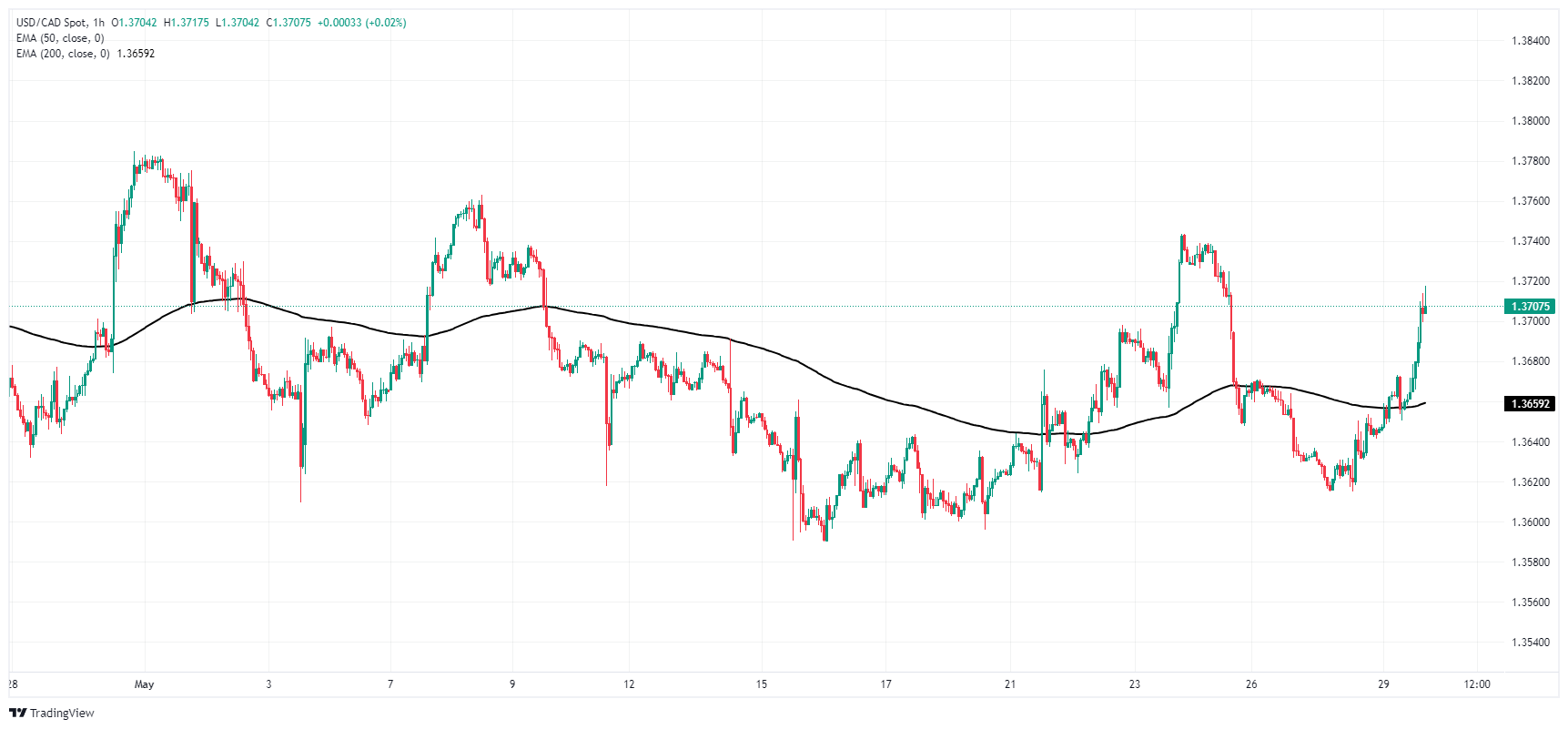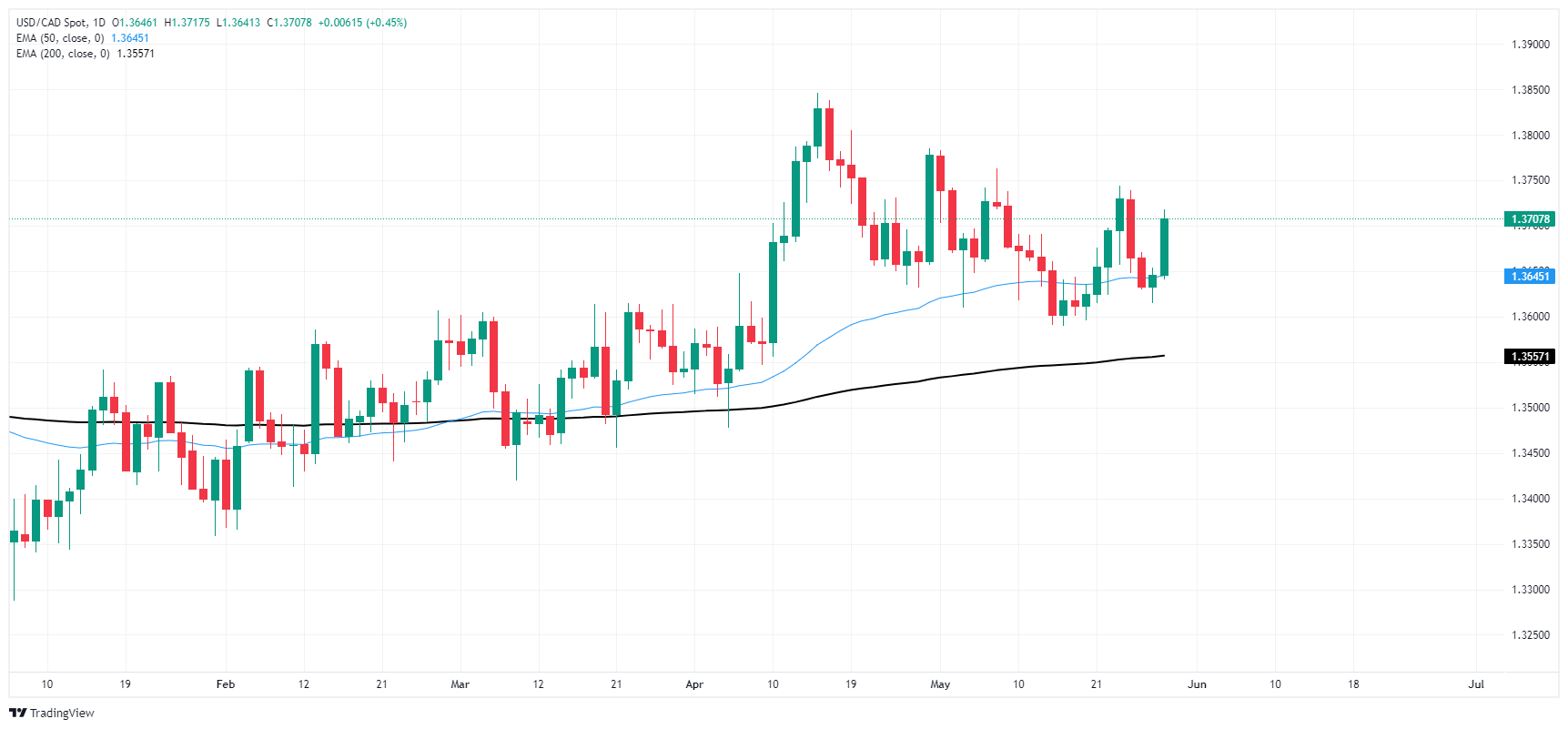Canadian Dollar adds to losses on thin Wednesday as Greenback rebounds
- Canadian Dollar broadly lower as Treasury yields bolster US Dollar bids.
- Canada absent from the economic calendar on Wednesday,
- Canadian Current Account, GDP update due later this week.
The Canadian Dollar is softening across the board on Wednesday, shedding weight as the safe haven Greenback catches a broad-market bid. Lackluster bid-to-cover ratios in a US Treasury auction on Tuesday is trimming market sentiment heading into the midweek, keeping risk appetite on the low side.
Canada remains absent from the economic calendar on Wednesday, leaving CAD traders to look ahead to Thursday’s Canadian Current Account, which is expected to fall to -5.5 billion after climbing to a six-month high of -1.62 billion in the previous quarter. Canadian Q1 Gross Domestic Product will follow on Friday, and is expected to settle to 0.0% MoM versus 0.2%. However, Canadian data is expected to be overshadowed by US data releases, with US GDP on Thursday and Personal Consumption Expenditure (PCE) Price Index inflation on Friday.
Daily digest market movers: Canadian Dollar recedes again as risk appetite withers
- Markets are keeping one foot in safe havens as investors grapple with declining bid-to-cover ratios on US Treasuries this week.
- Broad-market support for the Greenback is sending the CAD lower, extending Tuesday’s turnaround.
- A 7-year note auction will draw plenty of attention in the middle of the US session.
- Markets could push further into risk-off sentiment if bid-to-cover falls below 2.44.
- Investors will also be looking out for US quarterly GDP and PCE inflation in the latter half of the trading week.
- US Q1 GDP is expected to ease to 1.3% versus the previous 1.6%, while Core PCE inflation is expected to hold flat at 0.3% MoM.
Canadian Dollar PRICE Today
The table below shows the percentage change of Canadian Dollar (CAD) against listed major currencies today. Canadian Dollar was the weakest against the US Dollar.
| USD | EUR | GBP | JPY | CAD | AUD | NZD | CHF | |
|---|---|---|---|---|---|---|---|---|
| USD | 0.38% | 0.36% | 0.32% | 0.46% | 0.47% | 0.38% | 0.14% | |
| EUR | -0.38% | -0.03% | -0.09% | 0.08% | 0.10% | 0.00% | -0.24% | |
| GBP | -0.36% | 0.03% | -0.06% | 0.08% | 0.11% | 0.03% | -0.22% | |
| JPY | -0.32% | 0.09% | 0.06% | 0.15% | 0.16% | 0.07% | -0.18% | |
| CAD | -0.46% | -0.08% | -0.08% | -0.15% | 0.02% | -0.06% | -0.33% | |
| AUD | -0.47% | -0.10% | -0.11% | -0.16% | -0.02% | -0.09% | -0.31% | |
| NZD | -0.38% | -0.00% | -0.03% | -0.07% | 0.06% | 0.09% | -0.25% | |
| CHF | -0.14% | 0.24% | 0.22% | 0.18% | 0.33% | 0.31% | 0.25% |
The heat map shows percentage changes of major currencies against each other. The base currency is picked from the left column, while the quote currency is picked from the top row. For example, if you pick the Canadian Dollar from the left column and move along the horizontal line to the US Dollar, the percentage change displayed in the box will represent CAD (base)/USD (quote).
Technical analysis: Canadian Dollar finds room on the downside
The Canadian Dollar is weakening across the board on Wednesday, struggling to hold flat against the Australian Dollar (AUD) and shedding weight against all other major currency peers. The CAD is steeply lower against the US Dollar, sliding nearly half of a percent.
USD/CAD is sharply higher in the near-term, climbing nearly 0.7% from the last swing low below 1.3620. Whipsaws are populating the intraday charts as choppy trading weighs on the pair, and lower highs will crimp topside momentum beyond 1.3740.
Daily candles are pricing in a technical rebound from the 50-day Exponential Moving Average (EMA) at 1.3674, but long-term bullish momentum is limited as USD/CAD remains down from the year’s peak bids near 1.3850.
USD/CAD hourly chart
USD/CAD daily chart
Canadian Dollar FAQs
The key factors driving the Canadian Dollar (CAD) are the level of interest rates set by the Bank of Canada (BoC), the price of Oil, Canada’s largest export, the health of its economy, inflation and the Trade Balance, which is the difference between the value of Canada’s exports versus its imports. Other factors include market sentiment – whether investors are taking on more risky assets (risk-on) or seeking safe-havens (risk-off) – with risk-on being CAD-positive. As its largest trading partner, the health of the US economy is also a key factor influencing the Canadian Dollar.
The Bank of Canada (BoC) has a significant influence on the Canadian Dollar by setting the level of interest rates that banks can lend to one another. This influences the level of interest rates for everyone. The main goal of the BoC is to maintain inflation at 1-3% by adjusting interest rates up or down. Relatively higher interest rates tend to be positive for the CAD. The Bank of Canada can also use quantitative easing and tightening to influence credit conditions, with the former CAD-negative and the latter CAD-positive.
The price of Oil is a key factor impacting the value of the Canadian Dollar. Petroleum is Canada’s biggest export, so Oil price tends to have an immediate impact on the CAD value. Generally, if Oil price rises CAD also goes up, as aggregate demand for the currency increases. The opposite is the case if the price of Oil falls. Higher Oil prices also tend to result in a greater likelihood of a positive Trade Balance, which is also supportive of the CAD.
While inflation had always traditionally been thought of as a negative factor for a currency since it lowers the value of money, the opposite has actually been the case in modern times with the relaxation of cross-border capital controls. Higher inflation tends to lead central banks to put up interest rates which attracts more capital inflows from global investors seeking a lucrative place to keep their money. This increases demand for the local currency, which in Canada’s case is the Canadian Dollar.
Macroeconomic data releases gauge the health of the economy and can have an impact on the Canadian Dollar. Indicators such as GDP, Manufacturing and Services PMIs, employment, and consumer sentiment surveys can all influence the direction of the CAD. A strong economy is good for the Canadian Dollar. Not only does it attract more foreign investment but it may encourage the Bank of Canada to put up interest rates, leading to a stronger currency. If economic data is weak, however, the CAD is likely to fall.
